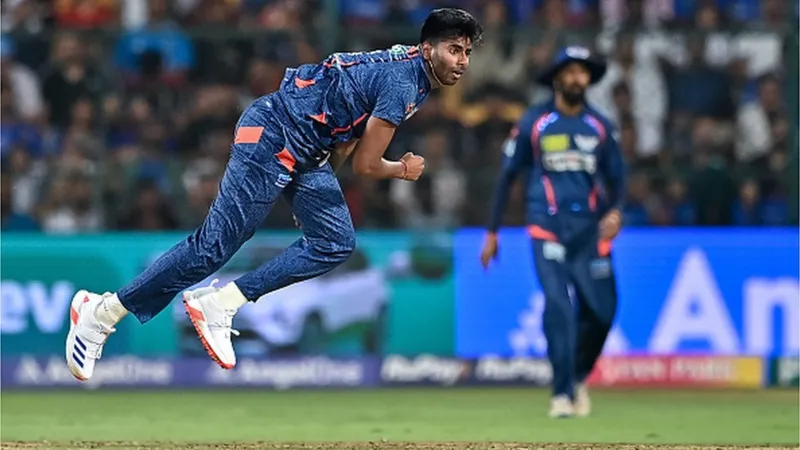MUMBAI: Every year, the Indian Premier League (IPL), the world’s richest cricket tournament, unveils rich talents.
Only twice though has there been awed chatter about a young Indian pace bowler because of their exceptional speed.
Umran Malik from Indian-administered Kashmir created a storm three years ago. In IPL 2024, it’s Mayank Yadav who is turning heads almost as quickly as he’s turning up the dial on speed guns.
The 21-year-old lanky bowler from Delhi made his IPL debut for Lucknow Super Giants against Punjab Kings in March and set pulses racing with a terrific spell of fast bowling. He bowled a delivery at 155.8 km/h (96 mph) and won the man-of-the-match award on debut.
In the next game Yadav went one better with a 156.7 km/h (96 mph) scorcher – the season’s quickest delivery so far – and a second successive man-of-the-match award against Royal Challengers Bangalore, an IPL first for a debutant. He picked up six wickets for 41 runs across the two matches.
Yadav’s performance prompted Ian Bishop, commentator and former West Indies bowler, to describe him as a “child of the wind”.
Dale Steyn, one of the greatest fast bowlers in history, and who Yadav described as his only idol, said on Twitter: “Mayank Yadav where have you been hiding!” In a tweet after his second game, Steyn simply wrote: “That’s a serious ball! #PACE”.
Former Australia player Tom Moody felt Yadav was “definitely in the conversation” to make India’s squad for the T20 World Cup that will follow the IPL.
What prompted the normally measured and seasoned experts to gush about Yadav after he had played only two matches?
For one, pace. Others have also topped 150 km/h in this IPL, but none as consistently as Yadav, or with quite the same ferocious effect.
But pace alone is seldom enough at the top level. What made Yadav stand out was his control. He hasn’t yet bowled a single extra in the IPL. He has varied his lengths without pace being affected. And then there’s the quality of batters snared, and the manner of their dismissals.
Against Punjab he accounted for Jonny Bairstow, one of the more accomplished players of fast bowling, by hurrying him on the pull shot, a sure-fire indicator of how quick he was.
He went even better against Bangalore, similarly dismissing Glenn Maxwell, one of the best T20 bats in the world.
He then beat another Australian star, Cameron Green, for sheer pace when uprooting his off-stump. Green is no stranger to fast bowling. Here, he stood frozen at the crease, bat hanging loosely, a tell tale sign of a batter anticipating a short delivery and belatedly reacting to one that wasn’t.
“He has some real extra speed that you don’t really see a lot of around world cricket at the moment,” Maxwell told ESPN, comparing Yadav to ex-Australia bowler Shaun Tait at his peak.
Fast bowlers commonly accept that the faster they bowl, the harder it becomes to maintain control. Tait and Malik have both faced that. So far, Yadav has defied the stereotype.
Other potential pitfalls await though.
Several Indian pacers have arrived on the scene as tearaway quicks, only to settle into the “medium-fast” category as the years go by.
Then there’s the constant risk of injury that comes with repeatedly executing the physically demanding action of fast bowling over extended periods.
After his first two games, Yadav encountered the looming threat of injury in his third match against Gujarat Titans.
He bowled just one over, hitting around 140 km/h, fast for most bowlers but below Yadav’s usual standard. Then he left the field with a side strain.
Team-mates said that Yadav seemed fine and there wasn’t much cause to worry. Even if he recovers quickly, this incident offers insight into the pressures of fast bowling and its impact on speed. Yadav has already contended with the issue – he missed the IPL last year due to injury.
Yadav’s journey started when his father, a police vehicle siren seller, enrolled him at Delhi’s renowned Sonnet Cricket Club. His pace caught the attention of former India cricketer Vijay Dahiya, then coaching Uttar Pradesh, during a net session at a domestic tournament.
Dahiya, who was also assistant coach with LSG, called up Gautam Gambhir, then the LSG team mentor, and said Yadav had to be signed. LSG bought Yadav for his base price of two million rupees in the IPL 2022 auction, but they didn’t play him the first year because he didn’t have enough “bowling miles” in his legs. But they never doubted his ability.
It’s still early days for Yadav. Many pitfalls have to be navigated.
The case of Malik is a reminder of how difficult the journey is. Malik played 10 ODIs and 8 T20Is for India in 2022 and 2023, but cannot currently command a guaranteed place in the first XI of his franchise, Sunrisers Hyderabad.
But if Yadav can stay fit, and continue to grow as a bowler, life will happen for him at 150km/h too.
BBC









Comment